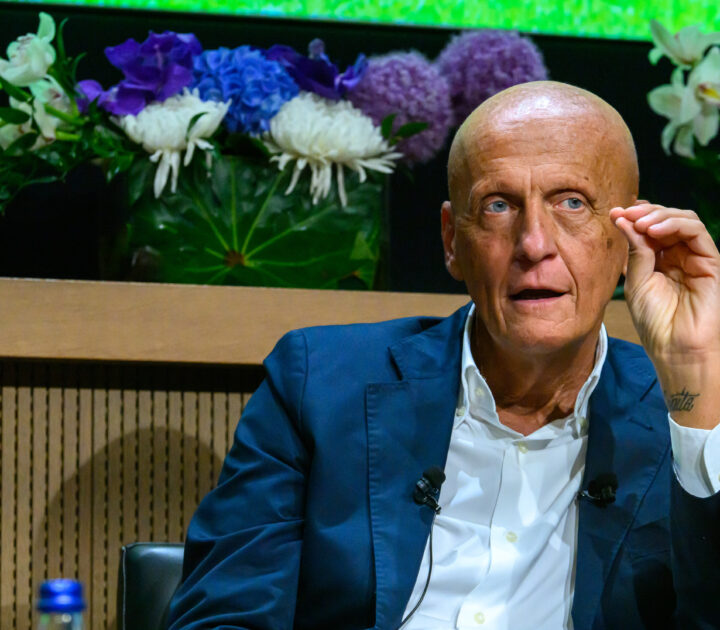
Goli Vada Pav story
The story
When Venkatesh Iyer co-founded Goli Vada Pav with Shiv Menon in 2004, he saw a big opportunity in selling affordable, clean, ethnic fast food to lower-income customers in India.
Mr Venkatesh, now chief executive, saw a potential market of 500m mostly teenage and young adult Indians paying Rs10 (about 20 US cents) or more to eat a vada pav, a typical Mumbai street-food dish of a spicy vegetable patty in a bun. He was also counting on big social changes under way in India, including longer commutes for lower-middle-class Indians, who he noted “don’t have so much time for food.”
Goli Vada Pav would occupy a potentially lucrative spot between traditional street-food vendors and global chains. The goal was to sell hygienically prepared food with an authentic touch.
The challenges
The company opened its first outlet in 2004 in Kalyan, near Mumbai, but soon ran into problems. The handmade patties varied in quality and had a short shelf life, and some were pilfered. Also, steep rises in raw material costs put margins under pressure.
In November 2006 Mr Venkatesh’s bank gave the company 10 days to stop the losses resulting from these problems or repay the bank’s loan.
The strategy
The response from Mr Venkatesh was to focus on the Goli Vada Pav brand and outsource much of the supply chain and operations.
He approached a friend who was CEO of Vista Processed Foods, a subsidiary of OSI, a US company that supplied frozen vegetable and chicken patties to McDonald’s in India. Vista agreed to supply frozen patties to Goli Vada Pav, which addressed the problem of inconsistent quality and short shelf-life. Another friend put Mr Venkatesh in touch with an engineering college in Mumbai, which improved consistency by helping to install automated fryer machines in the outlets.
Goli Vada Pav then secured fresh funding from Indian financiers on the basis that it would scale up quickly within three months. Real estate in Mumbai was expensive, so Mr Venkatesh experimented with operating through 350 state-owned milk kiosks, but abandoned this when local political parties tried to co-opt the company in campaigns.
Then, when Mr Venkatesh was trying to raise a second round of financing in late 2008, the global financial crisis prompted five potential investors to withdraw. This left Goli Vada Pav close to collapse because the company had spent most of its money on getting the milk kiosks ready to sell vada pavs.
At this point, he realised that “trying to sell vada pav in Mumbai is like selling pizza in Italy”, and decided to focus on second-tier cities in western and southern India. These cities had cheaper real estate, less competition from global chains and pent-up demand for branded food. Also, Goli Vada Pav enjoyed relatively high brand awareness thanks to local media coverage of its Mumbai milk kiosks experiment.
The company also moved to having just 75 full-time employees, with almost all its outlets run by fee-paying franchisees. Many were first-time entrepreneurs, attracted by the standardised product and relatively low requirements for franchisees regarding capital investment, physical space and labour.
The results
Goli Vada Pav has 156 stores, up from 20 at the end of 2009. It sells 75,000-100,000 vada pavs daily. Profitable and with revenues of about $3.2m in 2012, it plans to have 500 outlets by 2015. It is an established, reliable, well-known ethnic fast-food brand.
The lessons
First, Goli Vada Pav has grown rapidly by focusing on what it does best and finding good partners to do the rest. The only aspects of the business not outsourced are the brand and its proprietary spice mix.
Second, a founder has to be both persistent and adaptable. Mr Venkatesh was prepared to change the offering, to use contacts and to change geographical location.
This article first appeared in the Financial Times on September 4th 2012.
Research Information & Knowledge Hub for additional information on IMD publications
The case study delves into strategic transformation and leadership transitions at Unilever since 2009. Unilever has been an industry leader of busi...
Many executives say they don’t have time for mindfulness practices, such as daily meditation. An alternative is micro-presence: weaving moments of ...
Technological innovation, advances in remote work, and reshaped post-pandemic priorities have led to companies hiring fractional leaders, or part-t...
In recent years, sustainable leadership has emerged as a powerful force reshaping corporate strategies worldwide. At its core, sustainable leadersh...
Research Information & Knowledge Hub for additional information on IMD publications
Research Information & Knowledge Hub for additional information on IMD publications
Research Information & Knowledge Hub for additional information on IMD publications
in I by IMD 5 July 2024
Research Information & Knowledge Hub for additional information on IMD publications
in HBR.org 2 July 2024
Research Information & Knowledge Hub for additional information on IMD publications
in I by IMD 28 June 2024
Research Information & Knowledge Hub for additional information on IMD publications
Research Information & Knowledge Hub for additional information on IMD publications
Research Information & Knowledge Hub for additional information on IMD publications
in I by IMD 24 June 2024
Research Information & Knowledge Hub for additional information on IMD publications
Research Information & Knowledge Hub for additional information on IMD publications






